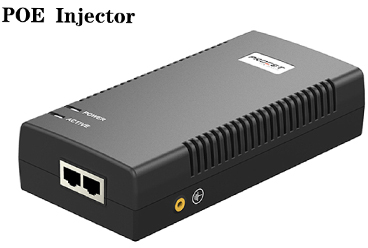Home >> News >> Product News
According to IEEE standard, PSE devices are divided into two types: MidSpan (PoE function module is outside the device) and Endpoint (PoE function module is integrated into the device). The PoE function modules of Huawei Cloudengine S series PoE switches are all integrated inside the equipment, and belong to the PSE equipment of Endpoint.
Endpoint PSE equipment can be divided into two power supply modes: Alternative A (1/2 and 3/6 pair) and Alternative B (4/5 and 7/8 pair) according to different power supply pairs.
Alternative A power supply mode supplies power through data. PSE supplies power to PD through 1/2 and 3/6 wire pairs. 1/2 link forms negative pole and 3/6 link forms positive pole. 10BASE-T and 100BASE-TX interfaces use 1/2 and 3/6 pairs to transmit data, and 1000BASE-T interfaces use all 4 pairs to transmit data. Since DC current and data frequency do not interfere with each other, current and data can be transmitted simultaneously on the same pair of lines.
Alternative B power supply mode supplies power through idle. PSE supplies power to PD through 4/5 and 7/8 wire pairs. 4/5 links form positive pole and 7/8 links form negative pole.
IEEE standard does not allow the above two power supply modes to be applied at the same time. The power supply equipment PSE can only provide one usage, but the power receiving equipment PD must be able to adapt to both situations at the same time.
PoE power supply negotiation process
After PSE equipment is powered on and PD equipment is connected to PSE equipment through the network, PSE and PD begin to negotiate power supply:
PD detection: PSE periodically outputs a small voltage with limited current at the port to detect the existence of PD devices. If a resistance with a specific resistance value is detected, it means that the cable terminal is connected with a receiving terminal device that supports IEEE 802.3af standard or IEEE 802.3at standard (for a specific resistance with a resistance value of 19k Ω - 26.5k Ω, the general low voltage is 2.7V - 10.1V, and the detection period is 2 seconds).
Power supply capability negotiation is the PD equipment classification process: PSE classifies PD and negotiates power supply. Power supply capability negotiation can be achieved not only by analyzing the resistance sent by PSE and PD, but also through the link layer discovery protocol LLDP (Link Layer Discovery Protocol) protocol to discover and notify the power supply capability.
Start power supply: within the startup period (generally less than 15 μ s) PSE equipment starts to supply power to PD equipment from low voltage until 48V DC voltage is supplied.
Normal power supply: After the voltage reaches 48V, PSE provides stable and reliable 48V DC power for PD equipment, and the power consumption of PD equipment does not exceed the maximum output power of PSE.
Power failure: During the power supply process, PSE will constantly monitor the PD current input. When the PD current consumption drops below the minimum value, or the current surges, such as unplugging the equipment or encountering PD equipment power consumption overload, short circuit, power supply load exceeding PSE, PSE will disconnect the power supply and repeat the detection process.

Negotiation of power supply capability through LLDP protocol
IEEE 802.1ab defines an optional TLV (Type Length Value): Power via MDI (Media Dependent Interface) TLV. LLDP message encapsulates Power via MDI TLV to discover and announce MDI power supply capability. When PSE detects PD, PSE and PD will periodically send LLDP message to each other, which contains the defined TLV field. Send the local information to the other party, and the other party records the information contained in the message to achieve information interaction.
However, the Power via MDI TLV format defined by IEEE 802.1ab can only negotiate power supply parameters of IEEE 802.3af and IEEE 802.3at standards, and cannot negotiate power supply parameters of IEEE 802.3bt standards. When the connected PD devices use IEEE 802.3bt standards for power supply, the standard Power via MDI TLV cannot negotiate power supply. Huawei S series switches define a power via MDI TLV to support negotiation of power supply parameters of IEEE 802.3bt standard.